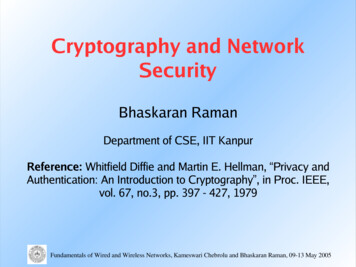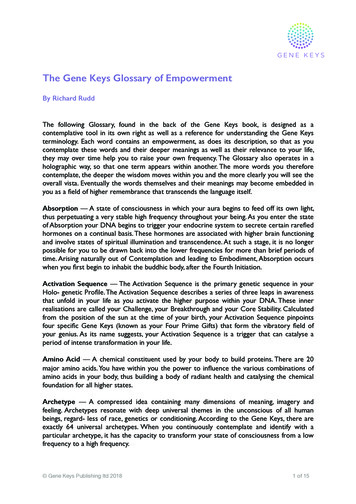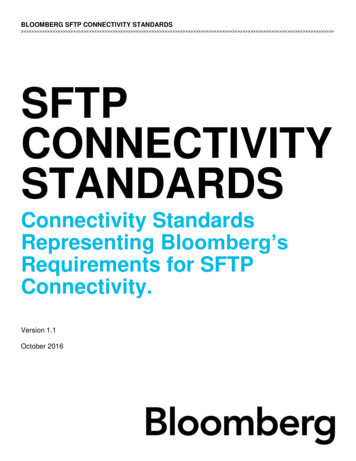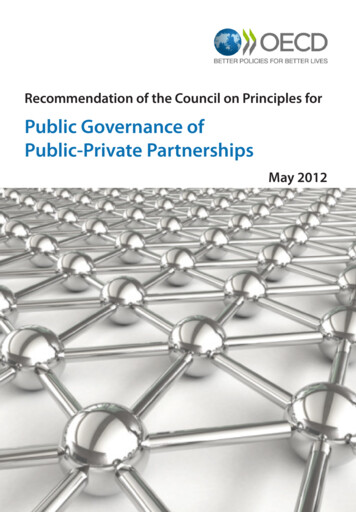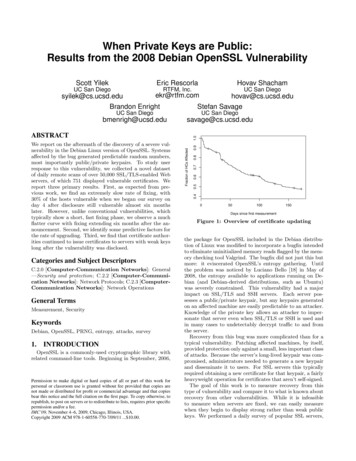
Transcription
When Private Keys are Public:Results from the 2008 Debian OpenSSL VulnerabilityScott YilekEric RescorlaHovav ShachamUC San DiegoRTFM, Inc.UC San duBrandon EnrightStefan SavageUC San DiegoUC San Diegobmenrigh@ucsd.edusavage@cs.ucsd.eduCategories and Subject DescriptorsC.2.0 [Computer-Communication Networks]: General—Security and protection; C.2.2 [Computer-Communication Networks]: Network Protocols; C.2.3 [ComputerCommunication Networks]: Network OperationsGeneral TermsMeasurement, SecurityKeywordsDebian, OpenSSL, PRNG, entropy, attacks, survey1.INTRODUCTIONOpenSSL is a commonly-used cryptographic library withrelated command-line tools. Beginning in September, 2006,Permission to make digital or hard copies of all or part of this work forpersonal or classroom use is granted without fee provided that copies arenot made or distributed for profit or commercial advantage and that copiesbear this notice and the full citation on the first page. To copy otherwise, torepublish, to post on servers or to redistribute to lists, requires prior specificpermission and/or a fee.IMC’09, November 4–6, 2009, Chicago, Illinois, USA.Copyright 2009 ACM 978-1-60558-770-7/09/11 . 10.00.0.90.80.70.60.50.4Fraction of HCs AffectedWe report on the aftermath of the discovery of a severe vulnerability in the Debian Linux version of OpenSSL. Systemsaffected by the bug generated predictable random numbers,most importantly public/private keypairs. To study userresponse to this vulnerability, we collected a novel datasetof daily remote scans of over 50,000 SSL/TLS-enabled Webservers, of which 751 displayed vulnerable certificates. Wereport three primary results. First, as expected from previous work, we find an extremely slow rate of fixing, with30% of the hosts vulnerable when we began our survey onday 4 after disclosure still vulnerable almost six monthslater. However, unlike conventional vulnerabilities, whichtypically show a short, fast fixing phase, we observe a muchflatter curve with fixing extending six months after the announcement. Second, we identify some predictive factors forthe rate of upgrading. Third, we find that certificate authorities continued to issue certificates to servers with weak keyslong after the vulnerability was disclosed.1.0ABSTRACT050100150Days since first measurementFigure 1: Overview of certificate updatingthe package for OpenSSL included in the Debian distribution of Linux was modified to incorporate a bugfix intendedto eliminate uninitialized memory reads flagged by the memory checking tool Valgrind. The bugfix did not just this butmore: it eviscerated OpenSSL’s entropy gathering. Untilthe problem was noticed by Luciano Bello [18] in May of2008, the entropy available to applications running on Debian (and Debian-derived distributions, such as Ubuntu)was severely constrained. This vulnerability had a majorimpact on SSL/TLS and SSH servers. Each server possesses a public/private keypair, but any keypairs generatedon an affected machine are easily predictable to an attacker.Knowledge of the private key allows an attacker to impersonate that server even when SSL/TLS or SSH is used andin many cases to undetectably decrypt traffic to and fromthe server.Recovery from this bug was more complicated than for atypical vulnerability. Patching affected machines, by itself,provided protection only against a small, less important classof attacks. Because the server’s long-lived keypair was compromised, administrators needed to generate a new keypairand disseminate it to users. For SSL servers this typicallyrequired obtaining a new certificate for that keypair, a fairlyheavyweight operation for certificates that aren’t self-signed.The goal of this work is to measure recovery from thistype of vulnerability and compare it to what is known aboutrecovery from other vulnerabilities. While it is infeasibleto measure when servers are fixed, we can easily measurewhen they begin to display strong rather than weak publickeys. We performed a daily survey of popular SSL servers,
beginning shortly after the bug was disclosed and continuingfor some six months. Approximately 1.5% of those serversdisplayed weak keys and we were able to study the timecourse of fixing. As shown in Figure 1, the replacement ofweak keys is a long, slow process, quite different from thefast fixing processes seen with typical vulnerabilities [15, 16].[Hashmarks on the diagram indicate censored units, whichstopped responding during the survey while still vulnerable.]Our survey also yields new information about real-worldSSL usage. Due to the bug’s effects, we can determine, foreach affected certificate, the architecture of the machine usedto generate it and the process ID of the responsible process.This is the first time such data has been available. Even forthe majority of sites unaffected by the bug, our data revealshow certificates of popular SSL sites are updated over time.Our collection of a new dataset by different methods allowsus to reexamine previous work on SSL server demographics. We believe our dataset will be useful for other studies.See the Web page for this paper for information on obtaining a copy: /.2.RELATED WORKWe build on two major previous lines of work: demographic surveys of SSL servers and longitudinal studies ofvulnerability fixing.SSL Server Surveys. There have been a number of previous surveys of the properties of SSL servers, mostly focusing on deployment of new versions of SSL, support forstrong cryptographic algorithms, and valid third-party certificates. In 2000, Murray [12] surveyed 8081 SSL serversand found that around a third supported “weak” algorithmsonly (shockingly weak, in fact, by modern standards). Healso found that around 10% of servers had expired certificates and around 3% had self-signed certificates. In 2005and 2006 Lee [9] et al. repeated and expanded upon thiswork with a sample of 19,429 servers. They found that thesituation had improved significantly; less than 5% of serverswere weak by Murray’s definition, although an uncomfortably high percentage of servers still supported the old “export” cipher suites ( 90%) and SSL version 2 ( 80%). Theydid not measure certificate validity.Netcraft [13] runs a monthly survey attempting to coverall servers on the Internet. While this survey does not measure cipher suite support, Netcraft does collect informationon certificate validity: they find that around 25% (estimatedfrom their figures; raw numbers were not provided) of siteshave self-signed certificates and less than half are from a“valid CA”. Netcraft doesn’t define this term but presumably it refers to one of the major CAs in the browser rootlist. Note that this data is very different from that reportedby Murray, who found mostly valid certificates. We shedsome light on this discrepancy in Section 7.1.While our work is not specifically intended as a replication of either Lee et al.’s or Netcraft’s research, we collectmuch of the same data as a side effect of our measurements.Section 7.1 describes some interesting contrasts.Studies of Vulnerability Fixing. The topic of upgrading rate in response to vulnerabilities has been studied byRescorla [16] and Ramos et al. [15]. The general pattern forexternally visible “critical vulnerabilities” seems to be of afast (half-life on the order of 10–20 days) exponential fixingphase immediately after the announcement of the vulnerability. The OpenSSL vulnerability studied by Rescorla provides probably the closest parallel: that study showed tworounds of patching, one in response to the initial vulnerability and one in response to the release of a worm. Eachwave was relatively fast, with the vast majority of patchinghappening within two weeks and almost none after a month.Ramos reports a similar set of patterns as well as that somevulnerabilities show only irregular decline or no decline atall (this may be an artifact of survey methodology). Thevulnerability we study exhibits yet a different pattern: along, slow, flat, fixing cycle that actually accelerates in thefirst 30 days with significant levels of fixing as far out as sixmonths. In Section 7.2 we provide some potential explanations for this difference.3.BACKGROUND: SSL KEY EXCHANGEIn order to understand the issues discussed in this paper,it is necessary to have a basic understanding of how SSLworks. In this section, we provide a brief overview of therelevant aspects of SSL. Although the purpose of SSL is toprotect data, like many other cryptographic protocols suchas SSH [20] and IPsec [4], it starts with a handshake phasewhich authenticates the peers and establishes joint keyingmaterial. That keying material is then used to protect thedata flowing between the communicating peers. Figure 2shows a highly simplified view of the most common variantof the full SSL handshake: “static RSA”. [The technical termfor the set of cryptographic algorithms used for a given SSLconnection is cipher suite.]ServerClientClientRandomo/ServerRandom, CertificateE(Kpub ,PreMaster Secret)/Figure 2: SSL static RSA handshakeIn the static RSA version of SSL, the server generates asingle, long-term RSA keypair (Kpub , Kpriv ) used for eachtransaction. In theory the server operator then acquiresa certificate from a well-known certificate authority (CA)attesting to the binding between the RSA public key andthe server’s domain name (e.g, www.amazon.com). Any clientthat trusts the CA can then verify that binding. In somecases, however, the server acts as its own CA and generatesa “self-signed” certificate. Such a certificate is just a keycarrier: clients cannot verify the server’s identity unless theyhave some independent channel for verifying the certificate.When the client contacts the server, it sends a randomnonce (the ClientRandom value). This is sent in the clearand is used solely to ensure uniqueness of the keying material for each connection. The server responds with its ownServerRandom value and a copy of its certificate. All of thisinformation is also known to any observer. The client canthen verify the server’s certificate and extract Kpub . It thengenerates a random PreMasterSecret (PMS) value; encryptsthat value under Kpub and sends the resulting EncryptedPreMasterSecret (EPMS) to the server. Because the serverknows Kpriv it can decrypt the EPMS to recover the PMS.
At this point, both the client and the server know the PMS,but any observer who doesn’t know the server’s private keydoes not. The PMS is then mixed with the client and serverrandom values to form the keys which are used to encrypttraffic between client and server.This exchange uses four random values: the server’s RSAkeypair, the client and server randoms, and the PMS. However, it’s important to recognize that the client and serverrandoms need not be secret (and in fact only really need tobe unique) and that the server’s RSA keypair is not generated in real-time; only the PMS must be generated securelyduring the connection.The other common full handshake variant, “ephemeralDiffie-Hellman” (DHE), is shown in Figure 3; it has a ratherdifferent set of properties. As before, the server has a longterm RSA key (sometimes this is a DSA key, but so rarely asto be irrelevant for the purposes of this discussion), but instead of having the client encrypt under that key, the clientand the server do a Diffie-Hellman key exchange, with eachside generating a new ephemeral DH key for the handshake.In order to authenticate the server side (as with static RSA,the client is not generally authenticated), the server signsits DH share with Kpriv . Once the client has received andverified the server’s share, it generates its own DH shareand sends it to the server. The combined DH shared secret(often known as ZZ) is used as the PMS.ServerClient/ClientRandomoServerRandom, Certificate,S(Kpriv ,Ys )Yc/Figure 3: SSL ephemeral DH handshakeUnlike the static RSA mode, in DHE mode both sides needto generate strong random numbers. The security of DiffieHellman depends on the randomness of both sides’ privatekeys; an attacker who can predict either side’s DH privatekey can decrypt the connection. By contrast, an attackerwho knows the server’s RSA private key can impersonatethe server but cannot passively decrypt connections whichuse DHE mode. This property is known as Perfect ForwardSecrecy (PFS).There is one final variant of SSL to consider, one in whichneither DH nor RSA is used. Because DH and RSA operations are fairly computationally expensive, SSL incorporatesa “session resumption” feature. The first time that a clientand server pair communicate they establish a PMS whichis then converted into a long-term MasterSecret (MS). Theserver provides the client with a “session id” which it can useto establish a new connection based on the same MS. Thesecurity of this resumed connection of course depends on theoriginal handshake, but because the client and server random values are new, the connection will use different traffickeys to encrypt the actual data, thus protecting against avariety of cryptographic attacks (replay, cut-and-paste, etc.)4.THE VULNERABILITYThe history of the Debian OpenSSL randomness vulnerability has been well-covered elsewhere [7, 6, 8], and we willnot repeat it. Instead, we explain the technical details ofthe bug and its implications for SSL security.4.1Overview of the BugOpenSSL’s pseudorandom number generator (PRNG), likeall PRNGs, is a deterministic function: an attacker whoknows all the inputs and the sequence of invocations canpredict the output. To make the PRNG secure, the entropypool must be seeded with many bytes from /dev/random oranother source of entropy that an attacker cannot predict.OpenSSL exposes two functions that update a program’sentropy state: RAND add and RAND bytes.1 The basic function used to update the entropy pool is RAND add. RAND addis called with a block of bytes b of length l. RAND add thenmixes all of these values into the PRNG entropy pool. Theeffect of the Debian bugfix is to modify ssleay rand addto mix in l but not b, with the effect that an attacker whoknows the calling sequence (which is mostly determined bythe program and not by the state of the machine) can predict the contents of the entropy pool and hence the outputof the PRNG.RAND bytes, the function used to generate new randomnumbers, also updates the PRNG state with the number ofbytes to be extracted and the program’s process ID (pid)at the time the call is made. Folding in the current pidensures that forked processes, which otherwise would haveidentical entropy pools, do not obtain the same values fromthe PRNG. (Reuse of random numbers renders many cryptographic protocols insecure.) It is the binary in-memoryrepresentation of the pid that is incorporated, so an attackmust consider the endianness and native word size of thetarget machine. Because RAND bytes folds in the numberof bytes extracted, asking first for 20 bytes and then for 10produces different output than if the calls are reversed.Because a program’s entropy pool starts in a known (allzero) state, a remote attacker can track its evolution if heknows:1. The sequence of calls to RAND add and RAND bytesmade by the program.2. For each call to RAND add, the number of bytes to beadded.3. For each call to RAND bytes, the number of bytes tobe extracted and the program’s process ID (pid) whenthe call is made.This analysis holds true even if a program’s behavior depends on the value of previous PRNG output, for examplein the standard method for prime generation. When thePRNG is considered part of the program, the entire systemis still deterministic given its initial state and its inputs.4.2The Effect of the Bug on SSLThe effect of this bug is contingent both on whether theclient or server is affected and on which cipher suites arein use. If the client random number generator is broken,a passive attacker can usually predict the traffic keys (nomatter what the cipher suite). In RSA mode, the attackercan predict the PMS (see, for example, Wagner and Goldberg [3]) and in DHE mode he can predict the client’s DHprivate key, which allows prediction of the PMS (Abeni,Bello, and Bertacchini, demonstrate this attack on DHE RSA1These are wrappers around the ssleay functions below.
cipher suites for command-line clients and servers [1] affectedby the Debian bug). However, as a practical matter theeffect of this bug on clients is limited because most popular Web browsers do not use OpenSSL: Internet Exploreruses Microsoft’s SChannel and Firefox uses NSS. Furthermore, Debian and other Linux distributions are not widelyused as Web-browsing platforms. The most popular Unixbrowser based on OpenSSL is KDE’s Konqueror, whose usage share — across all Unix platforms, not just Debian —is well under 0.05%.2 However, many popular non-Webclients as well as command line Web clients such as wgetuse OpenSSL and therefore are likely to be affected.Servers, on the other hand, represent a serious concern.OpenSSL is the dominant SSL implementation on serverplatforms, and Debian-derived distributions are popular onservers. There are two major avenues of attack: key generation and DH share generation.RSA Key generation. If the server RSA keypair was generated on an affected version of OpenSSL, then the attackercan directly recover the private key.The simplest and most common way to generate longlived RSA keypairs for OpenSSL-based servers is to run theopenssl genrsa program, invoked either directly or througha wrapper. This program uses the OpenSSL PRNG to generate the keys. As discussed in Section 4.1, each possible pidand platform configuration gives rise to a PRNG stream andthus to a unique RSA keypair. The attacker can pregenerateall those keypairs (this takes hours to days) and wheneverone of the public keys matches he immediately knows thecorresponding private key. Generating all possible keypairsis subtle; we give the details in Section 6.2.Because the knowledge of the private key is all that differentiates the server from other entities, any attacker whoknows the private key can impersonate the server. Thisattack can continue even after the server has replaced hiskey because the attacker still has a certificate/keypair andmany clients do not check certificate revocation lists (CRLs).Moreover, if a static RSA cipher suite is used, the attackercan passively monitor connections and recover the PMS andtherefore the traffic keys, thus gaining access to all the encrypted data as well as the ability to inject data of his choice.As discussed above, this latter attack is not possible withDHE cipher suites.It’s very important to realize that both of these attacksdepend solely on the machine that the keypair was generatedon; if that machine was affected by the bug but the SSLserver itself is not (either because it is not a Debian machineor because it has been patched), attacks are still possible.DHE Key Generation. By contrast, if the operationalserver is affected, then an attacker may be able to predictthe server’s DHE share even if the server’s RSA keypair wassecurely generated. For a simple server that handles a single connection and then restarts — for example, an IMAP orPOP server launched from inetd — then there would be asmall number of possible values for the server’s ephemeralprivate key Xs . The attacker can determine which of thesepossible keys is used for a connection by recognizing theServerRandom and ephemeral public key values that accompany each. Unfortunately for the attacker, predicting theserandom values for real-world Web servers is more spx?qprid 1&qpcustom Konqueror.cated than for the simple attack described by Abeni, Bello,and Bertacchini [1].3Consider the case of the most popular Web server, Apache,which uses a “thundering herd” architecture with multiplelong-lived worker processes. Each worker process handlesmultiple connections in sequence and, for each connection,calls RAND bytes one or more times, mixing the entropypool. Even with the Debian bug, the random values obtained by the process for the first connection it handles willbe different from those obtained for the second and subsequent connections. What’s more, the pattern of RAND bytesinvocations depends on the cipher suite and whether resumption is used. Thus, though we know the initial stateof the server, we rapidly accumulate uncertainty about itssequence of RAND bytes invocations. Unless an attacker canobserve the entire set of connections from server startup,predicting the sequence of random values quickly becomesinfeasible. Finally, each worker process has its own stateand the attacker cannot directly measure what worker process is handling any given connection. Thus, even an attacker who can observe all server activity still must do asignificant amount of work; we describe a full attack alongthese lines in Appendix A. This affects not only attackerswho wish to recover a connection’s PMS but also those whowish to fingerprint vulnerable servers using the predictableServerRandom values they emit.In contrast to the case where the server’s key is weak, thisavenue of attack is possible only when the client and servernegotiate a DHE RSA cipher suite. If the server’s randomness is weak but a RSA cipher suite is chosen, the resultingconnection is entirely secure, because it is the client thatsupplies the premaster secret.45.REMOTELY MEASURABLE DATAAs with other studies of this type, we collected data byremotely probing the server to determine its characteristics.Thus, the data we can report is limited to what we cancollect via this mechanism.As described above, servers can be affected by the bugwe study in several ways: the server software can be affected, the server keypair can be weak, or both. Ideally wewould like to be able to measure the evolution of both properties over time. This would allow us not only to replicateRescorla’s 2003 study [16] but also to measure a form offixing that is related to but distinct from server software:Whereas previous papers have focused on the response toattack on servers, this paper illustrates the response to anattack on the data sent by servers. Unfortunately, our ability to measure remotely does not allow this. Determiningthe vulnerability of the server keypair is straightforward:construct a list of the weak server keys and check to seeif the server’s certificate contains such a key. In addition,when we determine that a server’s key is vulnerable, thisalso gives us information about the machine on which thekey was generated (which will often be the server); the exactset of keys is somewhat platform specific and so we can ex3This was acknowledged by Bello in private communication, responding to an initial writeup of our analysis at http://www.educatedguesswork.org/2008/08/thedebian openssl prng bug an.html.4Note that this is contrary to the naı̈ve expectation that aprotocol’s security guarantees are destroyed when one partyrelies on predictable randomness.
tract the word size, endianness, and base OpenSSL version;see Section 6.2.By contrast, remotely measuring the quality of the serversoftware’s PRNG (as opposed to the keypair) is not straightforward. We cannot directly examine the PRNG for thereasons described in Section 4.2 and although some Apacheinstallations advertise the version of OpenSSL they are running, many Debian servers do not advertise this (it isn’tentirely clear what the controlling factor is). Even if wecould examine the version name, because the error was inthe Debian fork of OpenSSL, the OpenSSL version numberis not diagnostic here. Thus, we cannot reliably determinethe status of the server itself.As Murray [12] and Lee et al. [9] show, it is possible todetermine what parameters a server is willing to negotiateby probing it using a client with a limited set of options. Because our interest is primarily limited to bug fix deployment,our survey was less exhaustive (and less intrusive) but westill measure a number of the same parameters, and in particular what cipher suite the server will select when offeredthe default set from OpenSSL.This bug also affected SSH servers, and it is possible to remotely determine whether they have weak keys [11] — sourcecode examination suggests that it may also be possible todetermine the status of the server but we have not yet triedthat. We initially developed SSH probing tools as well, butultimately decided to measure only SSL servers. Our primary reason was logistical: SSL server operators expect connections to their servers from arbitrary sources. By contrast,unexpected connections to SSH servers are often perceivedas an attack. Indeed, the only complaint we received in oursurvey was from the operator of an SSH server that hadbeen inadvertently included on our probe list. In addition,because any given SSH server is used only by a relativelysmall number of users, it is less clear what a representativesample would look like.6.METHODOLOGYIn the remainder of the paper, we describe our survey ofSSL servers. Because only a small fraction of servers werelikely to run an affected version of Linux, we first needed tocollect a large set of servers to sample. Drawing up a list ofrepresentative SSL servers is not easy. A random scan of theIP space would be as likely to happen upon an unused “Youhave successfully installed Apache” site as PayPal’s servers.(Because the fraction of IPs serving content on TCP port 443is low, such a scan would also be intrusive.) Furthermore,while there exist lists, such as Alexa’s, of popular Websites,the popularity of a site is a poor proxy for the popularity ofits associated secure SSL site, if there is one. Many popularsites, such as the Drudge Report, serve a substantial amountof traffic over HTTP and none over HTTPS. We chose to usemeasured SSL usage as a selection procedure. Through theUC San Diego Information Security Office, which routinelymonitors UCSD network usage, we were able to obtain alist of all IP addresses to which a 1 KB or larger flow oftraffic on TCP port 443 had been detected in the 56-dayperiod ending 21:00 utc on Friday, May 16, 2008. This listcontained 59100 servers.Because our list of SSL server addresses consists of serversactually visited by a diverse user population of a large organization, we believe that it is more representative of SSLas deployed on the Internet than a random scan would be.We expect that the corpus of data we collected about theseservers will be of wider use.6.1Data CollectionUsing this list as our starting point, we constructed a simple program which would attempt to contact each server onthe list (directly connecting the IP address with no DNSlookup) and initiate an SSL handshake using the “openssls client -connect” command. If the handshake did notcomplete within 30 seconds, we marked the host as failedand moved on.5 The results for each run were then storedin raw form to a separate file for that host and day. The output is simply the output of OpenSSL, which includes: thenegotiated SSL protocol version; the server certificate chain;the selected cipher suite; the session ID; the computed master key; and the start time of the connection.Starting on the evening of Saturday, May 17, 2008, werepeatedly surveyed each host, initially running our scriptby hand and then, as we gained confidence, in a cron job.The result was a complete set of connection output for eachhost for each run. We did not attempt to restrict the hostlist to those hosts exhibiting weak certificates, thus avoidingthe need to have a complete weak key list at the beginningof the survey — which was convenient since generating thekey list is extremely time consuming.The result of this process was a rather large data set —each day’s data consumes approximately 200 MB and theentire set, representing connections to each server in our seton approximately a daily basis, is upwards of 30 GB6.2Generating Weak KeysAnalyzing the data requires identifying which servers wereusing weak keys, which in turn requires a list of weak keys.There is just 15 bits’ worth of process ID entropy, but otherparameters, described below, must also be accounted for.Previous weak-key generation efforts have used getpid interposition via LD PRELOAD, but this approach does not scale.We instead created a patch to OpenSSL 0.9.8h that allowseach of the relevant conditions to be simulated, and used thepatched version to generate our corpus of weak keys.Because the binary representation in memory of certainvalues is added to the entropy pool, not a canonical representation, our key generation must account for the targetplatform’s endianness and native word size. In addition, thepresence of a file called .rnd in the user’s home directoryaffects the behavior of OpenSSL’s command-line utilities. Ifit is present, its contents are added to the entropy pool. Accordingly, we must generate two sets of keys: ones assumingthe presence of .rnd, one its absence. (Because of the Debianbug, the contents of the randomness file are not consulted;all 1024-byte files produce the same result.) When .rnd ismissing, versions of OpenSSL before and after 0.9.8f havedifferent behavior that we must again account for.6 Debianderived distributions shipped versions with both behaviors,so we must account for both.5This took several iterations to get right. We had anticipated that OpenSSL would time out on its own, but thisonly applies to failed TCP connects. It will stall indefinitelyonce the TCP connect succeeded, which was an unpleasantsurprise. This sort of stall happened often enough that weended up having to parallelize our probes and use an alarmto kill stalled probes.6Earlier versions will add their struct stat to the poolwhether or not the stat call succeeds.
7Server cipher suite support is the notable exception.Note for non-statistician readers: different statistical packages often u
response to this vulnerability, we collected a novel dataset of daily remote scans of over 50,000 SSL/TLS-enabled Web servers, of which 751 displayed vulnerable certi cates. . In the static RSA version of SSL, the server generates a single, long-term RSA keypair (K pub;K priv) used for each transaction. In theory the server operator then acquires




